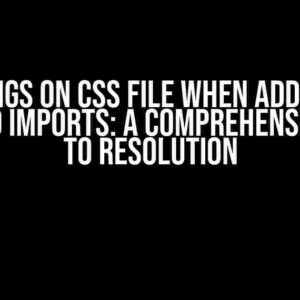Welcome to our comprehensive guide on iterating through all the days in a month in Django templates! If you’re struggling to fetch and display dates in your Django project, you’re in the right place. By the end of this article, you’ll be a master of date manipulation in Django templates.
Understanding the Problem: Why Do We Need to Iterate through Days in a Month?
In many web applications, we need to display dates in a calendar format, such as in a blog archive or a scheduling system. To achieve this, we need to iterate through all the days in a month and render them in our template. Sounds simple, but it can get tricky if you’re new to Django.
The Challenge: Django’s Date and Time Handling
Django provides an extensive set of date and time utilities, but working with dates can be confusing, especially when dealing with different time zones and daylight saving time (DST) adjustments. Don’t worry; we’ll break it down step-by-step to ensure you understand how to iterate through all the days in a month like a pro.
Step 1: Create a Custom Template Filter
Before we dive into the iteration process, let’s create a custom template filter to get the last day of the month. This filter will be used to generate the days of the month in our template.
# In your app's templatetags directory, create a new file called `date_utils.py`
from django.template import Library
from datetime import datetime, timedelta
register = Library()
@register.filter
def last_day_of_month(date):
if date.month == 12:
return date.replace(day=31)
return date.replace(day=31) - timedelta(days=date.replace(day=31).day - (date.replace(day=1) + timedelta(days=32)).day)
In the above code, we define a custom template filter `last_day_of_month` that takes a date object as an argument. It returns the last day of the month by checking if the month is December and adjusting the day accordingly.
Step 2: Create a View to Pass the Date Object to the Template
In your view, create a function that returns a date object representing the current month. We’ll use this date object to iterate through the days of the month in our template.
# In your app's views.py file
from django.shortcuts import render
from datetime import datetime
def month_view(request):
current_month = datetime.now().date()
return render(request, 'month.html', {'current_month': current_month})
In the above code, we define a view `month_view` that returns a date object representing the current month. We’ll pass this date object to our template as a variable `current_month`.
Step 3: Iterate through the Days of the Month in the Template
Now, let’s create a template `month.html` that iterates through the days of the month using our custom template filter and the date object passed from the view.
{% load date_utils %}
| {{ day }} | {% endfor %}
In the above code, we load our custom template filter `date_utils` and use a `for` loop to iterate through the days of the month. We start from 1 and use the `last_day_of_month` filter to get the last day of the month. The `add:1` filter is used to increment the day by 1 in each iteration.
Step 4: Customize the Output (Optional)
If you want to customize the output, you can use conditional statements to check if the day is a weekend or a holiday. For example:
{% load date_utils %}
| {% if day|week_day == 6 or day|week_day == 7 %} {{ day }} {% elif day == 25 and current_month.month == 12 %} {{ day }} {% else %} {{ day }} {% endif %} | {% endfor %}
In the above code, we use the `week_day` filter to check if the day is a weekend (Saturday or Sunday) and display it in red. We also check if the day is December 25 (Christmas Day) and display it in green.
Conclusion
Voilà! You’ve successfully iterated through all the days in a month in a Django template. With this article, you should now be able to create custom calendar views, blog archives, or scheduling systems with ease. Remember to customize the output to fit your project’s requirements.
Bonus Tip: Handling Leap Years
If you want to handle leap years correctly, you can modify the `last_day_of_month` filter to account for February’s 29th day in leap years. Here’s an updated version:
@register.filter
def last_day_of_month(date):
if date.month == 2:
if (date.year % 4 == 0 and date.year % 100 != 0) or date.year % 400 == 0:
return date.replace(day=29)
else:
return date.replace(day=28)
elif date.month == 12:
return date.replace(day=31)
return date.replace(day=31) - timedelta(days=date.replace(day=31).day - (date.replace(day=1) + timedelta(days=32)).day)
In the updated filter, we check if the year is a leap year and adjust the last day of February accordingly.
That’s it! I hope this comprehensive guide has helped you master iterating through all the days in a month in Django templates. If you have any questions or need further clarification, feel free to ask in the comments below.
Happy coding!
Here are the 5 Questions and Answers about “Iterate through all the days in a month in DJANGO template”:
Frequently Asked Question
Get the lowdown on iterating through all the days in a month in Django template with our expert answers!
How do I iterate through all the days in a month in Django template?
You can use the `calendar` module in your Django view and pass the days of the month as a variable to your template. Then, in your template, you can use a `for` loop to iterate through the days. For example, `{{ for day in days_in_month }} {{ day }} {{ endfor }}`. Don’t forget to import the `calendar` module in your view and calculate the number of days in the month using `calendar.monthrange(year, month)[1]`.
How do I get the current month and year in Django template?
You can use Django’s built-in `now` template tag to get the current date and time. For example, `{{ now }}` will give you the current date and time. To get the current month and year, you can use `{{ now.month }}` and `{{ now.year }}` respectively.
Can I use a Python loop in Django template to iterate through the days of the month?
No, you can’t use a Python loop directly in Django template. However, you can use Django’s `for` loop template tag to iterate through a list or other iterable object. In this case, you can pass a list of days in the month from your view to your template and use the `for` loop to iterate through them.
How do I handle leap years when iterating through the days of the month in Django?
When using the `calendar` module to calculate the number of days in the month, it will automatically take into account leap years. So, you don’t need to worry about handling leap years separately. The `calendar.monthrange(year, month)[1]` function will return the correct number of days for the month, even for February in a leap year.
Can I use a Django template filter to format the days of the month?
Yes, you can use Django’s built-in template filters to format the days of the month. For example, you can use the `stringformat` filter to add leading zeros to the day numbers. For example, `{{ day|stringformat:’02d’ }}` will format the day number with a leading zero if it’s less than 10.





